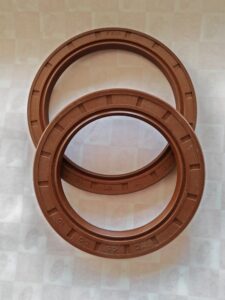Table of Contents
ToggleWhat is an S-Type Oil Seal?
An S-type oil seal (also called an S-seal or Type A radial shaft seal per DIN 3760/ISO 6194-1) is a standardized single-lip rotary shaft seal designed to retain lubricants and prevent fluid leakage in low-pressure applications. Its name originates from the S-shaped cross-section of its elastomeric sealing lip, which ensures reliable contact with rotating or reciprocating shafts. This article explores its design, standards, applications, and limitations.

Direct Answer
An S-type oil seal is a single-lip radial shaft seal with a spring-loaded elastomer lip housed in a metal case. It is optimized for low-pressure oil/grease retention in rotating equipment (e.g., motors, gearboxes) but lacks secondary dust exclusion features.
Design & Components
1. Core Structure
An S-type seal comprises three key components:
- Elastomer Lip:
- Made from nitrile rubber (NBR), fluorocarbon (FKM/Viton), or silicone.
- Forms the primary sealing edge against the shaft.
- Garter Spring:
- A helical spring embedded in the lip’s groove to maintain radial force and compensate for wear.
- Metal Case:
- Typically zinc-plated or stainless steel, providing rigidity and press-fit retention in the housing bore.
2. Cross-Section Profile
- The S-shaped lip creates dual sealing edges for enhanced fluid retention.
- Flexible design accommodates minor shaft misalignment and surface irregularities.
Standards & Specifications
S-type seals adhere to international standards for consistency and interoperability:
- DIN 3760 Design A: Defines dimensions, materials, and performance for single-lip seals.
- ISO 6194-1: Classifies rotary lip seals for low-pressure fluid retention.
| Parameter | Specification |
| Pressure Rating | ≤ 0.5 bar (7 psi) |
| Speed Limit | ≤ 12 m/s (rotary/reciprocating) |
| Temperature Range | -40°C to +100°C (NBR); up to +200°C (FKM) |
| Shaft Finish | Ra 0.2–0.8 µm |
Applications
S-type seals are ideal for clean, low-pressure environments:
- Electric Motors: Retain grease in bearings.
- Gearboxes: Prevent oil leakage in industrial machinery.
- Agricultural Equipment: Seal rotating shafts in tractors and harvesters.
- Pumps & Compressors: Lubricant retention in light-duty systems.
Advantages
- Cost-Effective: Simple design reduces manufacturing costs.
- Low Friction: PTFE-coated variants minimize energy loss.
- Easy Installation: Press-fit design suits closed-groove housings.
- Wear Resistance: Spring ensures consistent sealing force over time.
Limitations
- No Dust Lip: Cannot exclude contaminants; requires external wipers in dirty environments.
- Low Pressure Tolerance: Unsuitable for high-pressure systems (>0.5 bar).
- Limited Extrusion Resistance: Vulnerable to damage in large clearance gaps.
Comparison to Other Seals
| Seal Type | Key Feature | Pressure Range | Dust Exclusion |
| S-Type | Single lip + spring | ≤ 0.5 bar | No |
| TC (Double Lip) | Secondary dust lip | ≤ 0.5 bar | Yes |
| VAQ (High-Pressure) | Reinforced design | ≤ 10 bar | Optional |
Installation Guidelines
- Shaft Preparation:
- Ensure a smooth surface (Ra 0.2–0.8 µm) and chamfer edges to avoid lip damage.
- Housing Requirements:
- Use DIN 3760-compliant closed grooves (e.g., 25×52×7 mm for a 25 mm shaft).
- Mounting:
- Press-fit the seal squarely into the bore using a driver tool.
- Lubricate the lip and shaft to reduce startup friction.
Material Selection
- NBR (Nitrile): Standard for oil/grease; cost-effective.
- FKM (Viton): Resistant to high temps and chemicals.
- Silicone: For extreme low-temperature applications.
When to Avoid S-Type Seals
- Contaminated Environments: Use double-lip seals (e.g., TC type).
- High-Pressure Systems: Opt for reinforced seals (e.g., VAQ).
- High-Speed Shafts: Consider hydrodynamic seals with advanced lubrication.
Summary
The S-type oil seal is a foundational sealing solution for low-pressure rotary applications. Its simplicity, affordability, and compliance with DIN/ISO standards make it a go-to choice for retaining oils and greases in clean environments. However, its lack of secondary sealing features limits its use in harsh or high-pressure conditions. Always verify operating parameters against manufacturer specifications to ensure optimal performance.



Leave A Comment